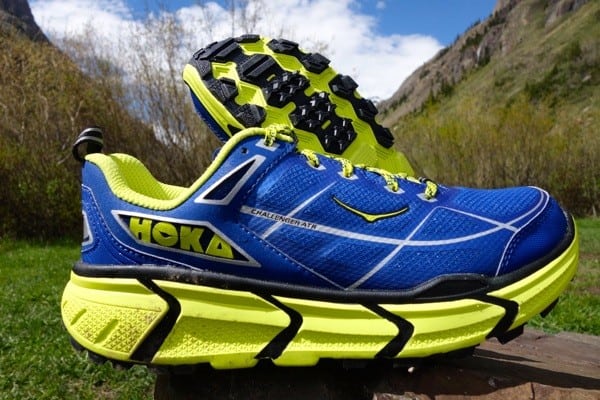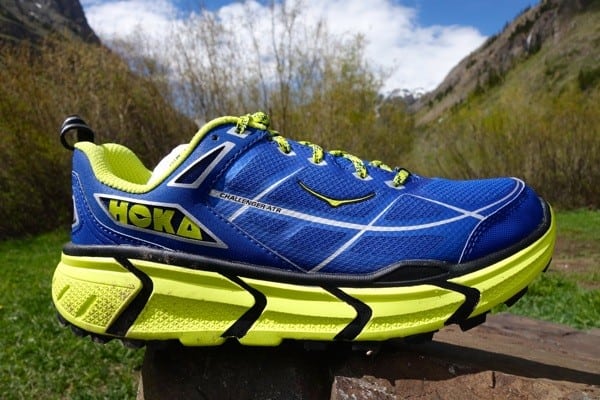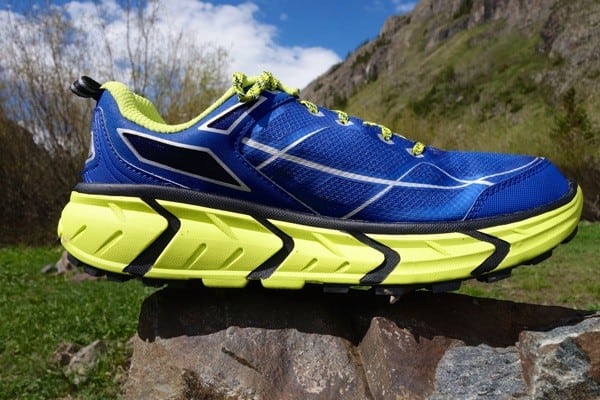Our Favorite Trail Running Shoes
Check out our Best Trail Running Shoes article to learn about our current favorite trail running shoes!
Hoka One One Challenger ATR Review
If maximalist trail running shoes are a narcotic, then the Hoka One One Challenger ATR ($130) is like a gateway drug. A place where previously minimalist trail runners dabble in the possible benefits of having extra protection underfoot, in the implausible hope that they will finish their next long run or ultra race with feet less battered. Anyone who is over 35 can tell you that at some point the old bones just don’t tolerate the pounding like they used to, no matter how fleet footed you are. In my attempts at looking for a fix, I purchased the Challenger to fit a void I’ve been experiencing lately. Namely, the perfect 100-mile shoe.
Now some of you have your favorites, but remember, my hobby is to be obsessive, even to the point of neurosis in this search, so that you don’t have to. Back in February I teased The Competitor Group for naming the Challenger ATR their “Shoe of the Year” award. I replied to their Twitter post with a casual, “C’mon guys, it’s February,” and then wondered if they were on to something. So, what follows is a subjective take on a great trail running shoe.

Hoka One One Challenger ATR. All photos: iRunFar/Bryon Powell
Upper
The Hoka Challenger ATR is based on the popular Clifton model, a 7.8-ounce road shoe with pillowy cushioning equal to that of a far heavier shoe. I’ve always thought of the Clifton as a Saucony Kinvara on steroids, and the cushioning is great for runners who desire a softer-durometer midsole in a lightweight package. This shoe absolutely shattered the Hoka mold and perception, but was really just a stripped-down shoe with great cushioning. The Challenger ATR is the trail version of this shoe, and the upper employs the same lightweight materials. Welded overlays provide a decent amount of structure throughout the upper, covering a fairly beefy mesh. Hoka uses a rubberized toe cap which provides a decent amount of protection, and a very thin tongue that stays in place and provides just enough comfort over the top of the foot.
I have heard from many runners that Hoka has narrowed the construction on the forefoot of their shoes over the past couple of years. Because of this, I was skeptical to try the Challenger ATR, feeling that it would result in pinched digits and a hemmed-in feeling. However, the combination of dual-density mesh and welded-on overlays have broken in well over the last 300 miles, allowing plenty of accommodation for my relatively wide forefoot. Understand, its not that my forefoot is exceedingly wide, but when I’m looking for a 100-mile shoe I know that I need to account for swelling late in the race. This is an upper that will provide some give and stretch over time, and it has molded to my foot a bit with additional wear.
I have been able to take the Challenger ATR through quite a bit of water crossings recently, and I will say that it drains fairly well. The midsole doesn’t seem to absorb any water but the mesh in the upper did hold onto more moisture than I expected, and my feet would still be wet over an hour after submerging them in a water crossing.

The Hoka One One Challenger ATR lateral upper.
Midsole
With 33 millimeters of stack height, the Challenger ATR appears to be very much a traditional Hoka shoe. However, at under 9 ounces the Challenger feels nimble and responsive during early runs. As with most Hoka shoes, the foot sits down in the EVA midsole alleviating the fears of rolled ankles or instability. While I found myself being more careful on steep, technical descents, the amount of cushioning allowed me to bomb anything cruiser or smooth. In fact, I would go so far as to say that I didn’t have any more difficulty on technical terrain in the Challenger as I normally would in a lower-profile shoe.
The Challenger ATR features a huge hunk of lightweight midsole which is 33% lighter than traditional EVA, and initially this shoe offers pillowy cushioning, especially given the sub-9-ounce weight. However, after the 250-mile mark I noticed a great deal of compression in the midsole foam which lead to sore feet over the 25-mile mark in races and long runs. I put the Challenger through multiple 20-mile runs when I first bought the shoe, but after experiencing the compounded compression during a 50k several weeks ago, I realized that this was not a shoe I would be racing 100 miles in. Simply put, the Challenger seems to be very resilient for about 200 miles, and then the EVA compressed and the shoe lost its plush feeling underfoot. While some runners may not be bothered by this change, I found that I was longing for the out-of-the-box feel and dropping another $130 was not a welcomed alternative.

The Hoka One One Challenger ATR medial upper.
Outsole
Surprisingly, this fairly low-profile outsole rubber provided excellent traction in all but the muckiest of surfaces. Durable carbon rubber is glued on high-wear areas of the outsole in the forefoot and heel, while the midfoot area of the outsole remains as soft and unprotected EVA foam. While it did take a beating, this uncovered EVA does provide excellent surface-area traction and the larger footprint of the Hokas works great on surfaces such as sand, snow, and sometimes mud. During the aforementioned 50k race, I encountered loads of clay-riddled mud, which turned my Hokas in moon boots. But after running through these sections I could feel the clay and mud being shed from the bottoms of the shoes and the low profile of the lugs aids in this process.
I have read reviews that some runners have experienced issues with the glued-on carbon rubber sections on the outsole. After 300 rugged miles, my Challengers don’t shoe any weak points or corners coming up on the outsole, and I’m positive that I could get 500 miles out of this shoe.

The Hoka One One Challenger ATR outsole.
Overall Impressions
By all accounts the Challenger ATR is a great trail shoe. Whether or not the wearer can tolerate the midsole compression that I experienced after about 250 miles will be purely a subjective experience. Runners who may initially be turned off by the softer-durometer feel out of the box might find that the longer they run in the Challenger, and the more the midsole compresses, the more enjoyment and firm underfoot feel they derive from the shoe. Conversely, for runners such as myself who enjoy that amazingly cushy ride, I’m not sure what Hoka could do to increase the resilience of this EVA. After all, even though most would consider this a maximal shoe, the construction is very minimal and Hoka doesn’t employ anything unnecessary that would add weight.
I hope that this review inspires a lively debate in the comments section regarding other’s experiences with the Challenger ATR. While I won’t be toeing the line at a 100 miler in this shoe, I am very much looking forward to future revisions and improvements as Hoka One One definitely has a winner with this design.
Call for Comments (from Meghan)
- Do you run in the Hoka One One Challenger ATR? What are your overall impressions of the shoe?
- What parts about it do you like the most and what would you like to see improved?
